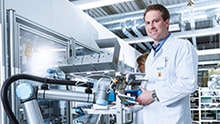What added value do customers gain from this tailored safety solution?
Pfaff: Our MELSEC iQ-F series is one of the leading PLCs in small and medium-sized machines and systems due to its wide range of features. The PLC family comes with diverse network connections, high-performance analog signal processing, and servo/motion control functionality already built in. Thanks to the safety solution with the FX5-SF-MU4T5 and its expansion module, it is also possible to equip the PLC with functional safety. While the safety module autonomously ensures functional safety, the interaction with the MELSEC iQ-F PLC over its system bus makes it possible to implement a reliable overall control concept.
Fritzsche: Specialists are hard to come by, in particular safety engineers. The advantage of this tailored safety solution is that it is very user-friendly. For example, it enables downstream or upstream parts of the machine to be checked without error-prone external wiring. This saves not only time but also costs.
Pfaff: Furthermore, the status of the safety application can be visualized in the HMI connected to the iQ-F, or via information systems connected by means of the network interfaces of the iQ-F.
What application for integrating machine vision have you developed?
Fritzsche: The solution combines the Inspector PIM60 2D vision camera from SICK with a PLC controller from Mitsubishi Electric and is suitable for a broad range of applications: from the automotive industry to food production right through to machine building. The solution allows, for example, a simple visual inspection of a packaging line. It can be used to check whether a cap has been inserted correctly, or a lid is in the correct position. A shape inspection in mechanical part production is one of the many other examples of common inspection tasks these days.
Pfaff: The solution we developed also gives the users of our control technology access to SICK's diverse portfolio in the area of machine vision. The ability to easily integrate sensors and control technology depends not only on the communication technology but also on the availability of helpful PLC programming tools. A core element of the developed solution is therefore function blocks for our GX Works engineering software that make integrating the machine vision into the control concept an uncomplicated process.







